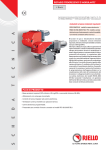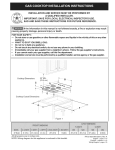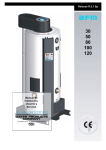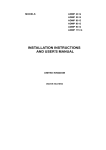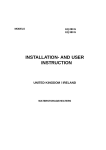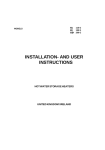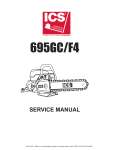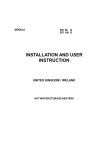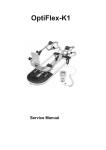Download A.O. Smith BFM 80 User's Manual
Transcript
MODELS BFM 30 BFM 50 BFM 80 INSTALLATION INSTRUCTIONS AND USERS MANUAL UNITED KINGDOM CLOSED COMBUSTION WATER HEATER INTRODUCTION Read the installation instructions before installing the water heater. Read the user-instructions before lighting the water heater. If these instructions are not followed carefully, this may lead to explosion and/or fire and can cause material damages and/or physical harm. Installation and commissioning should be carried out by a registered installer. The type of gas and standard values which the water heater (from factory) is set on, are stated on the type plate. The BFM-models fall under the instrument category; C13/C33. These water heaters are provided with an ignition system. A. O. SMITH DOES NOT ACCEPT ANY RESPONSIBILITY FOR GUARANTEE, SERVICE PROVISION AND/OR PRODUCT LIABILITY IN CASE OF UNAUTHORISED PRODUCT MODIFICATION OR REPAIRS. 2 CONTENTS PAGE 1. 1.1 1.2 1.2.1 1.2.2 1.2.3 1.2.4 1.2.5 1.3 1.3.1 1.3.2 GENERAL Water heater description ..................................................................................................................... 5 Technical safety equipment ................................................................................................................ 6 Gas control .......................................................................................................................................... 6 Control box ........................................................................................................................................... 6 Burner automat ................................................................................................................................... .6 Air proving switch ................................................................................................................................. 6 Gas control valve ................................................................................................................................. 6 Technical description .......................................................................................................................... 8 Measurements .................................................................................................................................... 8 Technical data ................................................................................................................................... 10 2. 2.1 2.1.1 2.1.2 2.1.3 2.1.4 2.1.5 2.1.6 2.2 2.2.1 2.2.2 2.2.3 2.3 2.4 2.5 2.6 2.7 2.8 2.9 2.10 2.11 FOR THE INSTALLER Installation instructions ..................................................................................................................... 11 Installation ......................................................................................................................................... 11 Water connection ............................................................................................................................... 11 Condensation drain ........................................................................................................................... 14 Gas connection ................................................................................................................................. 14 Flue connection (concentric) ............................................................................................................. 14 Electrical connection ......................................................................................................................... 16 Turning the water heater on .............................................................................................................. 19 Filling the water heater ..................................................................................................................... .19 Turning the water heater on .............................................................................................................. 19 Setting up the pilot flame ................................................................................................................... 19 Turning the water heater off ............................................................................................................... 19 Usage/temperature control ............................................................................................................... 19 Checking the gas pressures ............................................................................................................ 20 Conversion to another gas ................................................................................................................ 21 Maintenance ...................................................................................................................................... 22 Anode ................................................................................................................................................. 22 Descale procedure ............................................................................................................................ 22 Condensation .................................................................................................................................... 23 Spare parts ........................................................................................................................................ 23 3. 3.1 3.1.1 3.1.2 3.1.3 3.2 3.3 3.4 FOR THE USER Instructions for use ............................................................................................................................ 24 Warning ............................................................................................................................................. 24 Filling the water heater ...................................................................................................................... 24 Turning the water heater on .............................................................................................................. 24 Usage ................................................................................................................................................ 24 Turning the water heater off ............................................................................................................... 24 Maintenance ...................................................................................................................................... 24 4. 4.1 4.2 4.3 FAULT FINDING AND CORRECTION Fault finding userl .............................................................................................................................. 25 Fault finding installer ......................................................................................................................... 26 Detailed fault finding installer ............................................................................................................ 27 5. 5.1 5.2 5.3 5.4 5.5 5.6 5.7 WARRANTY Guarantee in general ........................................................................................................................ 31 Guarantee of the tank ........................................................................................................................ 31 Conditions for installation and use ................................................................................................... 31 Exclusions ......................................................................................................................................... 31 Range of the guarantee ..................................................................................................................... 31 Claims ............................................................................................................................................... 31 No other guarantee or warranty either expressed or implied is made on behalf of A.O. Smith Water Products Company ................................................................. 31 3 Figure 1 1) TOP-BOX 2) AIR PROVING SWITCH 3) TEMPERATURE REGULATOR ON/OFF SWITCH RESET-KNOB 4) BURNER CONTROLLER 5) GAS VALVE 6) MANIFOLD / INJECTORS 7) PILOT BURNER 8) HORIZONTAL AIR INLET 4 9) 10) 11) 12) 13) 14) 15) 16) 17) VENTILATION FAN ANODE FLUE TUBES FLUE BAFFLE DIAPHRAGM INSULATION BURNER AIR DIFFUSION PLATE CONDENSATE DRAIN 1. GENERAL 1.1 Description of the appliance Construction and fitting out of the storage appliance comply with the European Standard for gas fired hot water storage appliances for sanitary use (EN89). The appliance thereby satisfies the requirements of the European Directive for Gas Appliances, and is therefore entitled to bear the CE mark. The BFM appliance is an enclosed appliance with a fan in the air inlet ( appliance category C13 or C33 ). The appliance is designed for a concentric flue configuration. A diaphragm, across which the pressure difference can be measured, is fitted in the air inlet system. When the control thermostat calls for heat, the burner control unit carries out a zero position check. The fan is subsequently switched on and, at a signal from the pressure difference switch, the pre-ventilation period (minimally 30 seconds) commences. Following the pre-ventilation period the burner control unit switches on the ignition transformer whereby the first gas valve (the pilot) opens. On receiving an ionisation signal from the ignition burner, the second (main burner) gas valve opens. The appliance is now in operation. Technically this appliance falls into gas category II2L3P; the appliance is therefore suitable for natural gas as well as propane and butane gases. The storage appliance is suitable for working pressures to 8 bar. A connection is provided for the optional fitting of an extra safety feature, the temperature and pressure valve. The interior of the tank is enamelled for corrosion protection, and a number of magnesium anodes are fitted to the tank for the same purpose. A thick polyurethane insulating layer between the tank and its steel casing prevents unnecessary heat loss. If the storage appliance is completely filled with water it is under continual mains pressure. When hot water is tapped off the appliance, cold water is immediately introduced. Turbulence strips are placed in the fire tubes for the efficient transfer of heat. The flue gases pass their heat to the water by conduction and radiation. The flue gases are led to the flue via the top box. The burner bed consists of a number of bar burners. An injector is screwed into the manifold ahead of each burner, which ensures correct mixing of gas and primary air through injection into the burner inlet venturi. Secondary air is drawn between the bar burners. An air distribution plate, which also functions as a radiant heat shield, is fitted below the burners. Any condensation water produced is captured beneath the combustion chamber and led away via a siphon (see illustration 1). 5 1.2 Technical safety equipment 1.2.1 Gas control The water heaters are equipped with a gas control valve which regulates the flow of gas to the burner. The combination gas control is equipped with a safety valve, gas control valve, pilot safety valve and burner control (on a standard natural gas setting) 1.2.2 Control box For safety purposes, water heaters are always fitted with three thermostats: a control thermostat, a high-limit thermostat and an overheat thermostat. The desired water temperature is set with the control thermostat. To protect against freezing, the control thermostat is also fitted with frost protection which ignites the burner when the water temperature drops to 20oC, irrespective of the thermostat’s temperature setting. The overheat thermostat prevents the water reaching too high a temperature. Should both control and high-limit thermostats malfunction, the overheat thermostat will automatically shut down the water heater. The control thermostat can be set at settings 1-4 (approx. 40°C to 73°C). The frost protection ignites the burner if the water temperature drops below 20°C. The switch temperature of the high-limit thermostat is 84°C; the overheat thermostat cuts in at 93°C. The sensor for the control/frost thermostat is located at the level of the control switch; the sensors for the high-limit and overheat thermostats are located near the top of the water heater. The control box is fitted with an ON/OFF switch (I/0). At setting I, the gas control operates on the basis of heat demand from the control thermostat. At setting 0 the water heater is switched off. The burner will only ignite on the basis of heat demand from the frost protection. When the control thermostat calls for heat, the water heater checks all controls are in the off position. Power is then switched to the ventilation fan. Immediately the air pressure switch opens. The purge cycle starts. This runs for between 30 and 60 seconds after which the safety valve opens and the spark generator is operated. Gas flows to the pilot burner where it is ignited by the spark generator. The ionization probe now detects the flame, switches off power to the spark generator and opens the main gas valve.A softlite staged ignition control prevents explosive ignition by allowing a small percentage of total gas rate into the combustion chamber initially followed by the full rate when combustion is established. When the water temperature reaches the set point the water heater is turned off. If the flame extinguishes whilst in operation both the safety (pilot) valve and the gas valve will close immediately. If the control thermostat is still calling for heat the burner automation will repeat the ignition procedure. - If no flame is detected within the safety time of 50 seconds, the burner automation will interlock and the reset knob will light up. - As long as the air proving switch does not operate (remains closed), the burner automation will remain in the waiting position, while the ventilation fan 6 continues to work. - An interlocking of the burner automation can be cancelled out by pressing the reset knob. If the procedure does not succeed immediately, wait at least 15 seconds before pressing the interlocking knob again. If the flame detection falls out during normal operation, the burner automation will automatically repeat its ignition procedure. As long as a flame is detected within the safety period of 50 seconds, the automation will continue to repeat the ignition procedure. As soon as the water temperature has reached the set value, the burner automation will close the gas valves. The control column has a potential-free contact for external error message. 1.2.3. Ventilation fan The ventilation fan is installed in the top-box. When heat is required the ventilation fan is switched on by the burner automation. The fan switches off when the main burner has extinguished. The fan can be removed from the top box via the access panel. 1.2.4 Air proving switch The air proving switch ensures that there is sufficient air flow for the safe operation of the water heater. If the airflow falls below the preset value this will be detected by the air proving switch and the gas supply to both the ignition and main burners will be closed. The air proving switch is preset and cannot be adjusted. Air proving switches BFM-units Unit Pstart Poff (Pa) (Pa) BFM 30 250 220 BFM 50 250 220 BFM 80 230 205 The air proving switch must always be fitted with the connection points downwards! The air pressure differential switch must always be fitted with the connection points at the bottom, while the pipe with the letter H must be connected to the point P1. Pipe L goes to connection P2. 1.2.5 Gas control The water heaters are provided with a gas valve that regulates the gas supply to the burners. The gas control has a safety valve and a gas valve and hence has a B/D-configuration. The position of both valves can be regulated by the burner automation. To ensure improved ignition the gas control valve opening mechanism is fitted with a delay (softlite). Figure 2 - Positioning ventilation Figure 3 - Differential pressure switch 7 1.3 Technical description 1.3.1 Measurements See figure 4 Size BFM 30 BFM 50 BFM 80 A 1995 1995 2020 B 1795 1795 1820 C 600 600 600 D 520 520 525 E 600 600 590 F 1640 1640 1655 G 1360 1360 1360 H 630 630 625 K 710 710 710 L 1000 1000 1000 M 755 755 755 N 80/125 100/150 130/200 1 Cold water inletRP1½ 2 Hot water outletRP 1½ 3 Gas valve RP ¾ 4 Drain valve ¾"-14 NPT 5 T&P-connection (temperature- and pressure valve) 1"-14 NPT All dimensions in mm, rounded up to the nearest 5 mm. 8 IM D -0 05 7-R 0 Figure 4 9 1.3.2 Technical data Heater category:II 2H3+ Description Unit BFM 30 BFM 50 BFM 80 Nominal gas inlet pressure mbar 20 20 20 Burner pressure mbar 12.5 12.5 12.5 Input kW 29 47 75 Output to water kW 27 42 68 Gas consumption* m3/h 3.0 4.7 7.9 Diameter main injector mm 2.60 2.50 2.70 Diameter injector ignition burner mm 0.56 / 0.41 0.56 / 0.41 0.56 / 0.41 Heating time ∆T=45°C min 35 25 12 DATA NATURAL GAS G 20 DATA PROPANE/BUTANE G 30 - G 31 G30 G31 G30 G31 G30 G31 mbar 30 37 30 37 30 37 Input kW 29 28 46 44 75 71 Gas consumption kg/h 2.3 2.1 3.6 3.3 5.8 5.3 Diameter main injector mm 1.45 1.40 1.50 Diameter injector ignition burner mm 0.25 0.25 0.25 Nominal gas inlet pressure GENERAL Storage capacity litre 309 298 253 Number of bar burners - 3 5 Number of anodes - 2 2 4 Number of flue tubes - 5 7 16 Water connections - Rp11/2 Rp11/2 Rp11/2 Gas connection - Rp3/4 Rp3/4 Rp3/4 Drain connection - 3/4" - 14 NPT 3/4" - 14 NPT 3/4" - 14 NPT Anode - 3/4" - 14 NPT 3/4" - 14 NPT 3/4" - 14 NPT Connection T&P-plug** - 1” - 14 NPT 1” - 14 NPT 1” - 14 NPT Maximum working heat bar 8 8 Empty weight kg 270 290 7 8 350 * Gas usage at 1013,25 mbar and 15 °C. ** For a leak-tight connection European coupling pieces with pipe screw-thread according to ISO 228/1 or ISO 7/1 can be used on the NPT-connection nipples. 10 2. FOR THE INSTALLER 2.1.2 Water connections If possible, use a trolley or fork-lift truck to move the water heater. Always move the water heater in an upright position. 2.1 Installation instructions The following distances should be observed: - Sides of the water heater: (free space for the accessibility of the hand holes) - Rear of the water heater: - Around top-box and concentric pipe: - Front of the water heater: (free space to take out bar burners) 100 cm 15 cm 15 cm 100 cm 2.1.1 Installation Installation should be carried out in accordance with all local authority and building regulations, local water authority and fire regulations and the following British standards: British Gas Publication UP1 and UP2. BS 5482 part 1 1979 part 2 1979 part 3 1979 BS 6644 BS 6700 BS 6798 A.O. Smith water heaters are suitable for connection to vented, unvented and pumped pressurised systems. In each case appropriate valves and fittings should be used to ensure the system complies with the requirements of the water by laws, and appropriate building regulations. When fitting it is essential the rules of 'good practice' are applied at all stages of installation. Vented systems If the water heater is to be connected to a cold feed tank or cistern the hot water supply pipe must include an open vent which discharges over the cold feed cistern. The cold feed cistern must have an actual capacity of greater volume than the hourly recovery rate of the water heater(s) which it supplies.The minimum actual capacity is 50 gallons or 227 litres. See diagram 5. A.O. Smith water heaters are tested to a maximum pressure of 12 bar and a maximum working pressure of 8 bar. Dead legs on a hot water installation are undesireable. Where possible they should be avoided. Where the inclusion on the system of a dead leg is unavoidable the following restrictions should be applied: - for pipes not exceeding 19 mm. inside diameter; maximum lengh of dead leg permitted 12.0 metres; - for pipes exceeding 19 mm. but not exceeding 25 mm. inside diameter; maximum length of dead leg 7.5 metres; - for pipes with an inside diameter exceeding 25 mm. maximum dead leg 3.0 metres. IM D -0 06 5 1) 2) 3) 4) 5) 6) 7) Gas cock Stop valve Three way vent valve T&P valve Non-return valve Circulation pump Drain valve A) B) C) D) E) Gas supply Hot Water Cold Water Overflow Return circulation Diagram 5 - Typical UK vented system 11 Depending on the length and insulation of the water piping and the water demand frequency, it may be necessary to install a circulation system on the drain cock. The return pipe of the circulation piping can be fitted on the top of the drain cock after the sealing plug has been removed (see figure 6). Unvented To install an A.O. Smith water heater on an unvented cold water supply system a kit of valves and fittings listed by the water research centre and complying with part G3 of the current building regulations and BS 7206 should be used. Installation should be carried out generally as shown on diagram 7. Kits are available from A.O. Smith or our distributors. 1) 2) 3) 4) 5) 6) 7) 8) 9) Gas cock Stop valve Expansion vessel T&P valve Non-return valve Circulation pump Drain valve Pressure limiting valve Expansion valve A) B) C) D) E) Gas supply Hot water Cold water Hot water supply Return circulation Figure 6 IM D -0 06 6-R 0 Diagram 7 - Connection diagram (unvented system) 12 Depending on the water demand pattern (e.g., small amounts frequently), it may be necessary to circulate the water in the water heater to prevent temperature stratification. Therefore, we recommend that a circulation system is installed in the event of such demand patterns (see figure 8). Kits are available from A.O. Smith or our distributors. 1) Pump (type: Grundfos UP 20-15 N150, or similar) 2) Non-return valve 3) Gate valve 4) Drain valve 5) Gas valve A) B) C) D) Cold Water Hot Water Return circulation pipe Gas supply IM D -0 05 9 Figure 8 - Connection diagram including destratification circulation system 13 2.1.3 Condensation drain In order to guarantee the correct operation of the water heater, the condensate drain of the water heater must open into the sewer interrupted, provided with an extra stench trap or siphon. A condensation drain section fixed to the water heater should be fitted under the slope. The condensate drain of the water heater must never be sealed. 2.1.4 Gas connection The gas installation may only be carried out by a registered installer and in accordance with the relevant local authority and building regulations and followint British standards. 2.1.5 Flue connections (concentric) The combined flue discharge and air intake tubes (concentric) should always be assembled with a rising slope towards the flue terminal, and in accordance with the table below. IM D -0 06 0 figure 9 - Wall configuration (see figure 9) Type: Manufacturer: Pipe material flue tube: Pipe material air supply: Pipe diameter BFM 30: BFM 50: BFM 80: Angle: M2000 MDV SE Meulink & Grol Thick-walled aluminium with lip ring seal. Thin-walled galvanised steel plate. Ø 80 / 125 mm Ø 100 / 150 mm Ø 130 / 200 mm 90° (2 max.) Flue configuration / horizonal discharge BFM-unit Measurement BFM 30 BFM 50 BFM 80 min. max. min. max. min. max. A 0 7000 0 7000 0 7000 B 0 7000 0 7000 0 7000 A+B < 7000 < 7000 < 7000 All measurements are in mm. The following applies for the horizontal pipe: slope of at least 5 mm per metre of pipe to the water heater. NB. Measurements A + B are the total permissible dimensions of the flue, i.e. when A = 1 metre, B = 6 metres (total 7 metres) or A = 4 metres, B = 3 metres (total 7 metres). 14 - Roof discharge (see figures 10 and 11). Type: Manufacturer: Pipe material flue tube: Pipe material air supply: Pipe diameter BFM 30: BFM 50: BFM 80: Angle: M2000 DDV SE HR/VR Meulink & Grol Thick-walled aluminium with lip ring seal. Thin-walled galvanised steel plate. Ø 80 / 125 mm Ø 100 / 150 mm Ø 130 / 200 mm 45°/90° (max 2) Flue configurations roof discharge BFM-unit Measurement BFM 30 BFM 50 BFM 80 min. max. min. max. min. max. A 0 7000 0 7000 0 7000 B 0 7000 0 7000 0 7000 A+B < 7000 < 7000 < 7000 All measurements are in mm. these flue configurations. These will each equate to 1 metre of flue length. The following applies for the horizontal pipe: slope of at least 5 mm per metre of pipe to the water heater. A maximum of 2 bends (45° or 90°) may be used with The maximum flue configuration is therefore 7000 mm pipe, 2 bends (45°/90°) and a lead-through set. IM D -0 06 1 IM D -0 06 2 Figure 10 and 11 - Roof discharge. 15 2.1.6 Electrical connection All electrical connections must be carried out by a registered electrical contractor to the relevant regulations. The BFM must be connected to a supply voltage by means of a permanent electric connection and have a feeder cable not less than 3 x 1,0 mm². Supply voltage 220/240 VAC Supply network frequency 50 Hz Mínimum fuse required 1A The electrical diagram of the BFM-heater and the connections in the control-column are shown in figures 12 and 13. Electrical connection diagram BFM (see figure 12) A) Jacket B) Transformer 230V/238V/2VA C) Air proving switch D) EMC single phase filter E) RESET knob F) Thermostat frost G) Thermostat regulation H) Switch ON/OFF K) Thermostat overheat 93°C L) Thermostat high limit 84°C M) Automatic burner controller N) Plastic connector strip P) Earth terminal block S) Relais Colour-code cables: 1 Blue 2 Brown 3 Yellow/green 4 Red 5 White 6 White/orange 7 White/violet 8 Black 9 Black/green 10 Black/red 11 Black/white 16 IM D 0 05 5 R 1 Figure 12 - Electrical connection diagram BFM 17 IM D -0 06 3 Figure 13 - Connection diagram control-column. D) E) F) G) H) K) L) 18 Transformer 230 Air proving switch EMC single phase filter RESET knob Thermostat frost Thermostat regulation Switch ON/OFF M) N) P) R) X) Y) Thermostat overheat Thermostat high limit Automatic burner controller Relay Plastic connector strip Earth terminal block 2.2 Turning the water heater on 2.2.1 Filling the water heater 1. Assemble the drain-off tap and check that it is closed. 2. Open the cold water tap to the water heater and open all taps on hot water outlet points to vent them. The heater is filled as soon as cold water pours out of all outlet points. 3. Close all taps at hot water draining points. The heater is now under water supply pressure. At this pressure, the relief valve if fitted may not release water. 2.2.2 Turning the water heater on 1. Check whether the water heater is filled with water and whether the gas pipe to the water heater is open. 2. Vent the gas pipe by opening the pressure gauge nipple at the inlet side of the gas valve. Close the pressure gauge nipple as soon as the gas pipe has been vented. 3. Turn the temperature control knob fully to the left. 4. Turn on- the supply voltage by turning the main switch. NOTE: if the frost-thermostat is calling for heat the burner automation will immediately start its ignition procedure. 5. Turn the ‘I/O’-switch on the column to the ‘T’ position. The control lamp in the switch will light. 6. Turn the temperature control switch to the desired position, preferably position 3 (approximately 60°C). The burner will ignite; the water heater will now work automatically. 7. Check the standing pressure with a manometer which can be connected to the pressure gauge nipple. Check that the working pressure is set to the correct level (see table page 10). The position of the temperature control knob coincides with the following temperatures: Position 1 = app. 40°C Position 2 = app. 50°C Position 3 = app. 60°C Position 4 = app. 70°C At high temperatures, more calcium precipitation is caused in the water heater. Moreover, the standbylosses of the water heater are greater with higher temperatures. It is recommended to set the controlthermostat at approximately 60°C. For reasons of security, the water heater is provided with a high limit and safety thermostats. The high limit thermostat is an extra control set at 80°C and will operate in the event of excess temperature within the water heater. If the safety thermostat operates, the ‘RESET’ button must be pressed after the water has cooled down. The water heater will operate again in the usual manner. 2.2.3 Setting up the pilot flame The pilot flame has been adjusted in the factory and does not have to be checked. 2.3 Turning the water heater off For short periods: 1. Turn the temperature knob fully to the left and turn the ‘I/O’-switch in the ‘O’-position. For longer periods: 1. Switch off the supply voltage. 2. Close the gas tap in the supply line. 3. Close the water supply tap. 4. If there is danger of frost, drain the water heater. 2.4 Usage/temperature control The water temperature is controlled via the temperature regulator. If the temperature in the water heater falls below the set value, the temperature regulator will call for heat. The burner automation will operate firstly the ventilation fan for its purge cycle, then a spark will ignite the pilot burner. The softlite control then ignites the main burner. 19 2.5 Checking the gas pressures The nominal load has been set at the correct value in the factory. A further check of the pressure should be carried out during the commissioning of the unit. A dangerous situation can occur if the following instructions are not followed carefully. Setting the nominal load is possible as there is a burner pressure control. If you wish to adjust the burner pressure the following procedures must be followed: 1. Switch off main power by turning the I/O switch to ‘0’ position. Figure 14 - Checking the gas pressures 20 2. Connect the U-tube manometer to pressure nipple B. 3. Switch on main power and ensure temperature control is calling for heat. 4. Wait until water heater is firing. 5. Check pressure against table on page 10 for relevant gas and adjust at main gas valve. 6. Switch of main power as no. Y. 7. Remove U-tube manometer and close pressure nipple. 8. Switch on main power and test for gas tightness and correct operation, (Figure 14). 2.6 Conversion to another gas Important: Install a gas valve suitable for the type of gas to be used. If the water heater has to function on a gas category (LP or natural gas) other than the gas set as standard (ex works), the water heater must be converted to the applicable gas category with the associated conversion kit(s). Only an accredited installer may convert the heater. All the injectors of the main burner bars and the injector of the ignition pilot must be replaced. Regurlary natural gas units do have a burner pressure regulator, but LP-gas units do not. The burner pressure regulator on the gas control must be removed when converting the heater for use on LPgas (if present). The burner pressure regulator must be fitted on the gas control when converting to natural gas (if required) The table with technical data shows which injectors must be fitted for the gas category in question. Procedure: 1. Shut the water heater down; close the main inlet gas valve and switch of the electricity supply at the main switch; 2. Remove the burner tray including the gas valve: a. remove the screws of the burner tray housing, b. loosen the wiring of ingition and ionisation pen on the burner controller, c. loosen the gas control cable, d. dismount the gas supply to the gas valve; 3. Remove the burner tray from underneath the heater; 4. Replace the main injectors and the injector of the ignition burner. Use the table with technical data to check that the diameter of the injectors is correct; 5. Converting from natural gas to LP-gas: a. remove the burner pressure regulator on the gas control, b. mount the flat covering plate with sealing provided in the conversion kit, c. see figure 15; Converting from LP-gas to natural gas: a. remove the flat covering plate with sealing on the gas control, b. mount the burner pressure regulator on the gas valve, c. See figure 16; 6. Mount the burner tray; 7. Reconnect the wiring and gas supply to the gas valve; 8. Open the main inlet gasvalve; 9. Check the gas inlet pressure; 10. Switch on the electricity supply at the main switch; 11. Commision the water heater; 12. Adjust the burner pressure to the value as indicated in the technical data; 13. Check the soundness; 14. Check the operation of the heater; 15. Fix the conversion sticker from the conversion kit below the rating plate to the heater, so that is clear on which gas category the heater operates. A O S 05 4 6 Figure 15 - mounting covering plate with sealing on the gas valve A O S 54 7 Figure 16 - mounting burner pressure regulator on the gas valve, 21 2.7 Maintenance The water heater must be checked and cleaned regularly (at least once a year) by an accredited installer, so that proper operation is guaranteed. The bar burners, control and safety valves must also be checked. (see figure 17). 2.8 Anode The life of the anode is determined by the quality and the quantity of water flowing through the water heater. Therefore, we recommend that the anode is checked regularly - preferably simultaneously with an internal inspection of the enamelled tank. In order to determine the frequency with which the anodes must be replaced, the water side of the boiler must be checked three months after installation. The anodes must be replaced if more than 50% has dissolved at any point on their length. Procedure: 1. Shut off the cold water supply tap. 2. Completely empty the water heater by means of the draw-off tap. Remember to ventilate the water heater. 3. Remove the sealing plates at the hand holes on the outer cover of the water heater. 4. Open the hand holes and inspect the anodes. In order to guarantee a water-tight seal at the hand holes, the rubber O-rings must be replaced (see figure 18). If the anodes need replacing: 1. Disassemble the concentric flue tube. 2. Disassemble the electrical connection of the ventilation fan on the top-box. 3. Loosen the fastening bolts of the top-box. 4. Remove the top-box, the positioning of the anodes will now become visible (see figure 18). 5. Loosen the anodes with suitable tools and replace with new ones. NOTE: the anodes must be in contact with the tank (metal on metal). For if the anodes and tank are electrically separated (as a result of the sealant used), the anode cannot perform its function. This can shorten the life-span of the tank. 6. Assemble everything in reverse order. 7. Fill the water heater. 2.9 Figure 17 Descale procedure Calcium deposition depends on the type of water and the demand. In addition, calcium deposition increases at high water temperatures. A temperature setting of 60°C is recommended, which will keep calcium deposition to a minimum. Inspection hatches are located on the right and left sides for inspecting and deliming the tank. The hand holes can be reached via the covering plates on the outer jacket. Empty the water heater before opening the inspection hatches. Deliming must be executed with the correct tools. Consult the supplier of the water heater or the installer on this matter. In order to guarantee a water-tight seal of the hand holes, the rubber O-rings in the hand holes must be replaced (see figure 17). 22 Figure 18 - Maintenance anodes 2.10 Condensation If the water heater has been filled with cold water or if the hot water usage has been very high, normally condensation of the flue gasses will occur on the cold sides of the combustion chamber and the flue tubes. The water drops will fall on to the burner bed which can cause a hissing sound. This is normal and will disappear as soon as the water heater has reached its operating temperature again. 2.11 Spare parts To order spare parts, it is important to state the water heater type, model and the complete serial number. Figure 19 - Maintenance anodes 23 3. FOR THE USER 3.3 3.1. Instructions for use For short periods: 1. Turn the temperature knob fully to the left and turn the ‘I/O’-switch in the ‘O’-position. Installation and commissioning of the water heater should only be undertaken by a registered installer. 3.1.2 Filling the water heater 1. Assemble the drain-off tap and ensure it is closed; 2. Open the cold water tap to the water heater and open all taps on hot water drain-off points to vent them. The heater is filled as soon as cold water pours out of all drain-off points; 3. Close all taps at hot water drain-off points. The heater is now under water supply pressure. At this pressure, the relief valve if fitted may not release water. 3.1.3 Turning the water heater on 1. Check that the water heater is filled with water and that the gas pipe to the water heater is open; 2. Turn the temperature control knob fully to the leftl; 3. Turn on( the supply voltage by turning the main switch. NOTE: if the frost-thermostat has been turned on, the burner automation will immediately start its ignition procedure); 4. Turn the ‘I/O’-switch on the column in the ‘T’ position. The control lamp in the switch will now light; 5. Turn the temperature control switch in the desired position, preferably position 3 (approximately 60°C). The ventilation fan will start. the water heater will ignite and work automatically. 3.2 Usage The water temperature is controlled via the temperature regulator. If the temperature in the water heater falls below the set value, the temperature regulator call for heat. The burner automation will operate firstly the ventilation fan for its purge cycle, then a spark will ignite the pilot burner. The softlite control then ignites the main burner. The temperature is indicated by the position of the temperature dial: Position 1 = app. 40°C Position 2 = app. 50°C Position 3 = app. 60°C Position 4 = app. 70°C At high temperatures, more calcium precipitation is caused in the water heater. Moreover, the standbylosses of the water heater are greater at higher temperatures. It is recommended that the controlthermostat be set at approximately 60°C. For reasons of security, the water heater is provided with a high limit and safety thermostats. If the high limit thermostat operates, the burner will not fire until the water has cooled sufficiently to allow the thermostat to automatically reset. The water heater will then return to the control of the temperature regulator. If the safety thermostat operates due to high temperature the ignition sequence must be repeated after resetting the control. 24 Turning the water heater off For longer periods: 1. Switch off the supply voltage; 2. Close the gas tap in the supply line; 3. Close the water supply tap; 4. If there is danger of frost, drain the water heater. 3.4. Maintenance The water heater must be checked and cleaned regularly (at least once a year) by an accredited installer, so that proper operation is guaranteed. The bar burners, the pilot burner and the control and safety valves must also be checked. 4. FAULT FINDING 4.1 Fault finding USER No or insufficient hot water. Check whether the electricity is turned on. Reduce the water use or increase the control thermostat. Check whether the gas supply is turned on. yes yes Does the ON/OFF switch light up? yes Does the RESETswitch light up? yes no Check if ON/OFF switch in position 1? Push RESET switch up to three times yes no no Is the water heater in operation? Put ON/OFF switch in position 1? Is the water heater in operation? Is the water heater in operation? yes Problem solved yes Problem solved no no Consult your installer. 25 4.2 Fault finding INSTALLER Check gas connection and the electricity supply make sure that they are switched on. Problem solved yes Does the ON/OFF switch light up? Does the RESET switch light up? yes Is the water heater in operation? no no yes Check if ON/OFF switch is in position 1? Push the RESET button up to three times no Put ON/OFF switch in position 1. no Is the water heater in operation? no Is the water heater in operation? yes Problem solved no no See detailed fault finding 26 yes Problem solved 4.3 Detailed fault finding INSTALLER Check voltage present at connection 1. no Reinstate voltage supply yes Check voltage present after FILTER no Ensure connections correct, if yes replace FILTER no Ensure connections correct, if yes replace ON/OFF switch no 1. Check if controle thermostat is closed 2. Ensure connections correct. 3. If yes replace CONTROL THERMOSTAT. yes Check voltage present at gate 3 ON/OFF switch yes Check voltage present at gate 11 and 12 CONTROL THERMOSTAT. yes 27 yes Check voltage present at GATE 12 MAXIMUM THERMOSTAT? no Ensure connections correct, if yes replace MAXIMUM THERMOSTAT yes Check voltage present at GATE 1 BURNER AUTOMATION S4560D 1150? no Ensure connections correct, if yes replace BURNER AUTOMATION no Replace BURNER AUTOMATION no Ensure connections correct, if yes replace VENTILATING FAN yes Check voltage present at GATE 8 BURNER AUTOMATION yes Is VENTILATING FAN in operation? yes Check voltage present at GATE 7, BURNER AUTOMATION no Check voltage present at GATE 3 AIR PROVING SWITCH yes no Check voltage present at GATE 1 AIR PROVING SWITCH yes yes Ensure connections correct DISCONNECT GAS SUPPLY yes Check voltage present at GATE 7, BURNER AUTOMATION yes 28 no Replace BURNER AUTOMATION Disconnect the pipe air supply by removing the elbow at the rear bottom. Measure pressure at hose H at the column. no Ensure connections correct, if yes replace BURNER AUTOMATION yes Check voltage present at GATE 12 ECO no Pressure H higher then 300 PA? Ensure connections correct, if yes replace ECO Ensure connections correct, if yes check hose H for leakkage or blockings yes yes Check voltage present at GATE 11 BURNER AUTOMATION no no Measure pressure at hose H at the column Ensure connections correct Pressure L less then 0 PA? no Ensure connections correct, if yes check hose L for leakkage or blockings yes yes Check exhaust system on blockings if the exhaust system is open, replace AIR PROVING SWITCH Check voltage present at GATE 10 BURNER AUTOMATION yes no Check voltage present at GATE 2 BURNER AUTOMATION no Replace BURNER AUTOMATION no Ensure connections correct, if yes replace RESET switch yes Problem solved Does the RESET switch light up? yes RESET the water heater and wait one cycle, advanced Fault Finding 29 Water heater in in operation? yes Problem solved no Gas supply present? no Re-instate gas supply and reset water heater yes IONISATION PROBLEMS. Carry out 3 RESET cycles to make sure the pilot is provided with gas. Check gasconnections towards the pilot burner. Carry out one more RESET cycle. If no operation is valid replace the entire PILOT BURNER assy. RESET water heater after replacing the PILOT BURNER Water heater in operation? yes Problem solved no Check voltage on PRIMARY CIRCUIT, TRANSFORMER Ensure connections correct no Ensure connections correct. If yes replace transformer yes Check voltage on SECUNDARY CIRCUIT, TRANSFORMER yes Problem solved 30 no 5. WARRANTY and laundries or where some industrial degreasing products are used and stored (for further information and advise please contact the A.O. Smith Technical Department). The following conditions form the guarantee agreement between A.O. Smith Water Products Company (the warrantor) and the owner of the water heater. 5.5 5.1 Guarantee in general If within one year of the original installation date of the water heater any part or component other than the tank shall prove upon examination by the warrantor or authorised agent to be defective in material or workmanship, the warrantor will exchange such part or component. 5.2 Guarantee of the tank If within 3 years of the original installation date, the tank fails due to rust or corrosion from the water side, the warrantor will supply a complete new water heater of equivalent size and duty (excluding delivery and installation charges). On the replacement water heater a guarantee will be granted sufficient to cover the unexpired portion of the original 3 year guarantee of the originally installed water heater. 5.3 Conditions for installation and use The guarantee applies to the water heater only while it remains in its orignial location, and is installed in accordance with local plumbing and building regulations and all relevant Codes of Practice. The water heater should also have been used only: a) for potable water free to circulate at all times and with the tank free of damaging scale deposits; b) at temperatures not exceeding the maximum setting of its thermostat and ECO (Energy Cut Off device); c) at water pressures and/or energy inputs which do not exceed those stated on the rating plate of the water heater; d) in a non corrosive atmosphere or area; e) with an approved temperature and pressure relief valve of adequate capacity not exceeding the working pressure rating shown on the water heater, and installed in conformity with A.O. Smith Water Products Companies installation instructions; f) when anode(s) have been inspected and renewed, if they are worn or erroded by 50% of more at any point of their length. 5.4 Range of the guarantee All replacement water heaters supplied under the terms of this warranty will be supplied ex stock on an F.O.B. basis. A.O. Smith accepts no responsability for carriage, labour or other installation costs. 5.6 Claims Any claim under this warranty should be initiated with the dealer who originally sold the water heater or with any other dealer or stockist of the warrantors products. 5.7 No other guarantee or warranty either expressed or implied is made on behalf of A.O. Smith Water Products Company. With respect to the water heater in question further A.O. Smith does not guarantee this water heater as suitable for purpose except within the terms of warranty detailed above. A.O. Smith Water Products Company will not be liable by virtue of this guarantee or otherwise for damage to any persons or property when arising out of contracts or tort. The terms of this guarantee do not effect your statutory rights under United Kingdom Consumer Legislation. This guarantee applies to the following models: BFM 30 BFM 50 BFM 80 Exclusions The guarantee will be null and void: a) if the water heater has been damaged by an external cause; b) in case of misuse, neglect (including frost damage) or incorrect use of the water heater; c) in case of unauthorised alteration, modification or repair; d) in case of ingress into the water heater of chemicals, pollutants or contaminants; e) if the hardness of the incoming water is, or has been, softened below 106 ppm CaCO3 ; f) if the water heater is effected by corrosive vapours such as those found in hairdressers, dry cleaners 31 0305 664 R0 32
































